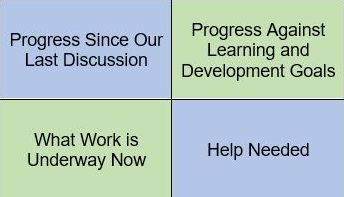It’s a new year, full of promise and opportunity. For many managers, this is a time with competing priorities – completing end-of-year performance evaluations while also setting objectives for the coming year. This can be a struggle, especially if your process for collecting information for assessing your employees’ progress against their objectives is something you only do at review time. In today’s post, I’m going to suggest some ways to improve an important component of your performance management process – the 1-on-1 meeting with your employees.
This note may also be useful for people who are not in management roles. If you and your manager don’t have regular 1-on-1’s, you could suggest starting the practice. The format I describe below can be a good starting point.
Why Conduct 1-on-1’s?
Meeting 1-on-1 with your direct report employees is a common part of many managers’ routine. These meetings can provide multiple benefits for you and your employee. They provide an opportunity for candid conversation that can build or strengthen your relationship. In addition, they provide a good way to get insight into an employee’s work, his or her aspirations, and attitudes. 1-on-1’s also provide an opportunity for you to provide feedback and coaching.
Many managers use the 1-on-1 meeting simply as progress checkpoints or status reports, but with a little bit of structure they can be much more productive and can help you streamline the performance review process, too.
7 Tips for Effective 1-on-1’s
Agree on how often to have 1-on-1’s. This can vary, depending on many factors, including how long you and your employee have worked together, the degree of coaching and guidance you feel you need to provide, and the employee’s preference. My rule of thumb was always to start with a weekly meeting, especially if the person was new to my team or to the company. If you start with a weekly cadence, you can always revisit the timing periodically and decide if it makes sense to switch to every two weeks. With more senior employees, you may decide that a monthly 1-on-1 is sufficient. One watch out: The less frequent your meetings, the longer the gap between them if one has to be cancelled. If you’re meeting every two weeks and one session is cancelled, it can mean you go a month between conversations.
Get them on the calendar, in a consistent time slot that you can plan around and defend from other demands. This will help reinforce with your employee that these are important conversations that are a priority for you. Whether you send the invitations or ask your employee to do it is up to you, but make certain you have both committed to a regular schedule for at least the next quarter.
Pick a consistent setting that is comfortable and private. If you have an office with a door, use it. If not, reserve a conference room. You want to create a safe space, where you can have a candid discussion, without interruptions or the risk of other people overhearing. It’s ok to change the venue periodically – maybe walk outside on a nice day, or occasionally go to a restaurant or coffee shop – just be aware of any privacy concerns. Avoid talking about confidential or sensitive matters when you’re in a public place.
Be “present” for the conversation. Focus your attention on the employee. If you bring a computer to the meeting, use it only for taking notes or sharing material pertinent to the discussion. Close your email client and chat apps. If you know you’re going to be interrupted or must multitask (a bad idea, but that’s a topic for another day), acknowledge the fact and offer to reschedule if you feel you can’t give your full attention.
Establish an agenda. This doesn’t have to be a formal agenda. Think of it more like a framework that guides the conversation. You may have topics that you want to discuss every time you meet. You may want to dedicate some meetings to specific topics, like detailed status reports on major projects. Your meetings can also include items that are addressed infrequently, like quarterly or half year performance reviews. I also suggest making time to talk with your employee about his/her career aspirations and personal or professional developmental ideas. This could be as simple as asking “What do you want to learn this quarter?”
The free 1-on-1 Meeting Template contains an outline of discussion topics for an entire quarter.
Let the employee lead. After all, this is his or her time. I would usually start a conversation by saying something like, “What’s on your list today?” and allowing the conversation to reflect the employee’s priorities, even if it took us away from a planned agenda topic. If your employee has urgent concerns or issues, you want to get them addressed first.
Establish a system for capturing notes that benefits both you and your employee. By keeping notes on a regular basis you create a repository of information that will make preparing self-assessments and performance reviews much simpler.
A basic format that I and others have used successfully is based on a “Four Quadrants” model that organizes information around four key topics, as shown below.

Each of the Quadrants represents a topic for conversation. Your employee can fill out the template in advance of the meeting and review it with you during your 1-on-1.
- Progress Since Our Last Discussion – Very simply, what has been accomplished since we last talked? This should focus on the most important objectives in the employee’s work plan, but may also include any special projects or assignments.
- What Work is Underway Now – Current activities in process that support the important objectives and assignments.
- Progress Against Developmental Objectives – Provides an opportunity to talk about new learning or other activities in the individual’s personal and professional development plan.
- Help Needed – What assistance does the employee need from you?
In addition to the Four Quadrants notes, I suggest you include notes about new assignments that you make or your employee identifies as well as recording any action items for both of you.
The 1-on-1 Meeting Template provides a simple way to organize information using the Four Quadrants model in advance of your 1-on-1’s, capture notes and action items during the meetings, and document the results so your build your information repository week by week.
By collecting this information in a structured and consistent way, you will have an ongoing record of your employee’s progress against his/her objectives and development plan along with notes on areas where your assistance was requested. When the next performance evaluation is due, you will each have six to twelve months’ of notes to draw upon.
How to Conduct a 1-on-1 Meeting
Here is a simple outline you can use to structure your 1-on-1 meetings.
- Greet the employee with a smile and call them by name. This helps indicate that you are present and interested in the conversation you’re about to have. Ask about their weekend or other outside of work activities.
- Compare notes on priority topics for the meeting. “What’s on your list today? Here’s what’s on mine.” Agree on the priority topics and the order in which to discuss them.
- Acknowledge any distractions or interruptions that might occur. Decide if you need to postpone or reschedule the meeting.
- Have the discussion of each topic. You job is to:
- Listen when your employee is speaking.
- Reflect for clarity, particularly if it’s a new topic. Play back what you’ve heard and ask if you understood it.
- Ask questions. Some questions will be to help clarify your understanding. (“Can you say more about your assumptions for that project?”) Other questions might be to prompt the employee to consider a different point of view or approach. (“Have you asked for your customer’s opinions on the new product?”)
- Answer questions. Your employee will be bringing concerns and questions to you. Often these will be the big, burning questions, the ones Stephen Covey called “rice bowl issues” – things that impact their livelihood or career. Answer truthfully, if you can. Acknowledge when you can’t. (“I have some information, but I can’t share it with you at this time.”) Then indicate when you think it would be appropriate to discuss further or when you think additional information will be forthcoming. If you don’t know the answer, say so and agree to follow up, then add a note to the Action Items list.
- Take notes – at least enough to remind you of the discussion at a later time. My suggestion: Capture complete thoughts in real time. My shorthand notes were almost always unintelligible when I read them later.
- Listen when your employee is speaking.
- Seek closure at the end of the meeting. Allow a few minutes at the end of the allotted time for anything not on the agenda. I would usually ask, “What else should we discuss today?”
1-on-1 meetings were an important part of my routine as a manager. I hope this article will be helpful as you consider how to incorporate 1-on-1’s into your management style.
If you’re conducting 1-on-1’s regularly, what other tips or techniques have worked for you? Leave a comment below with your thoughts and suggestions.
The free 1-on-1 Meeting Template will help you start or improve your 1-on-1 meetings.
